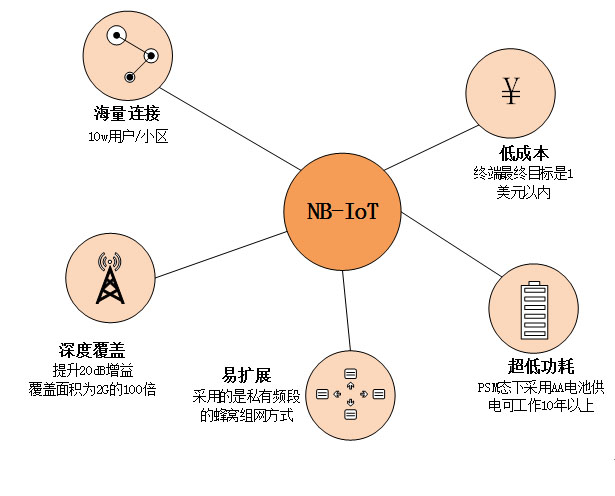What is NB-IoT
NB-IoT is a wireless cellular network communication protocol. It is the abbreviation of NArrow Band Internet of Things, which means narrowband Internet of Things. It is a low-power wide-coverage Internet of Things technology (LPWA). Narrowband only refers to the bandwidth used is 180KHz. , working within the operator’s authorized frequency band, NB-IoT has also been pushed to the forefront in the IT industry. NB-IoT technology is based on LTE R13, so it is easily compatible with existing mobile networks and plays an increasingly important role in IoT communications. Therefore, the three major operators are stepping up the network deployment of NB-IoT. .
What is the NB-IoT protocol?
When a certain resource is limited and is needed by multiple individuals, various rules are often established in order to utilize the resources more rationally. In communication, the transmission media and transmission time required for information interaction are limited. , and it is what all communication parties compete for. At this time, it is necessary to establish a set of communication protocols, that is, communication rules. All communication participants jointly abide by this agreement for information interaction, so as to achieve high effectiveness of information interaction within limited resources. and high reliability to achieve optimal utilization of resources.
The NB-IoT protocol is a set of wireless cellular network communication rules designed to make full use of precious wireless spectrum resources and time resources to meet the needs of LPWA. Its function is to develop a set of syntax, semantics and timing for information interaction. Simply put, It is a rule that stipulates the language used by communication participants to communicate, what the words mean, who speaks and who listens, and how long they speak.
Characteristics of NB-IoT network


Ultra-low power consumption: Adding PSM function, the current consumption of the terminal in this mode is about 3uA, and it can drive the module to work for 10 years even with dry batteries;
Massive connections: A single cell’s 180KHz bandwidth can support 100,000 user access, which is thousands of times the number of LTE connections;
Deep coverage: NB-IoT supports three CE Levels (coverage enhancement levels) of 0, 1, and 2, which can resist signal attenuation of 144dB, 154dB, and 164dB respectively. Compared with GSM and LTE, it is 20dB higher and the coverage area is increased by 100 times. , under the same conditions, NB-IoT can provide deeper coverage;
Ultra-low cost: The manufacturing difficulty and cost of the terminal are reduced by simplifying the protocol and removing functions that are of little significance to IoT applications. It has now been reduced to less than 3 US dollars and can be reduced to less than 1 US dollar in the future;
Uplink-based: Unlike traditional cellular networks, which are connected by “people”, the applications of “things” in the Internet of Things are mostly based on uplink data. Therefore, the traffic model of NB-IoT is dominated by the above-mentioned behavior;
Low rate: LPWA uses multiple transmission control parameters, small data volume, low communication frequency, and insensitive delay. Therefore, the NB-IoT network relaxes the service delay to 10s;
Half-duplex: NB-IoT uses FDD mode and uses half-duplex for communication. The components required for half-duplex are lower in cost and can reduce power consumption, further reducing the cost and power consumption of the terminal. ;
ST/MT two modes: Single Tone (single frequency) mode can provide business transmission services to more users at the same time, and can provide an uplink transmission rate of about 15kbps; Multiple Tone (multi-frequency) mode can make full use of spectrum resources , improves user transmission rate and can provide users with an uplink transmission rate of about 62kbps; NB-IoT uplink supports two sub-carrier spaces, 3.75kHz and 15kHz, of which 15kHz must be used in MT mode.
Application of NB-IoT module
There are 8 application areas for NB-IoT modules:
- Utilities: meter reading (water, gas, electricity, heat), smart water services (pipe network, leakage, quality inspection), smart fire extinguishers, fire hydrants.
- Smart buildings: access control, smart HVAC, smoke detectors, fire alarm detection, elevator failure/maintenance.
- Smart cities: smart street lights, smart parking, urban trash can management, public safety, alarms, construction sites, urban water level monitoring.
- Agricultural environment: precision planting (environmental parameters: water, temperature, light, medicine, fertilizer), livestock breeding (health, tracking), aquaculture, food safety traceability, urban environment monitoring (water pollution, noise, air quality PM2.5) .
- Logistics and warehousing: assets, container tracking, warehousing management, fleet management, logistics (status, tracking).
- Consumers: wearable devices, bicycles, moped anti-theft, smart luggage, VIP tracking (children, elderly, pets, vehicle rental), payment/POS machines.
- Medical health: drug traceability, remote medical monitoring, blood pressure monitors, blood glucose meters, and heart armor monitoring.
- Manufacturing industry: production and equipment status monitoring; energy facilities, oil and gas monitoring; chemical park monitoring, large rental equipment, predictive maintenance (home appliances, machinery, etc.).
